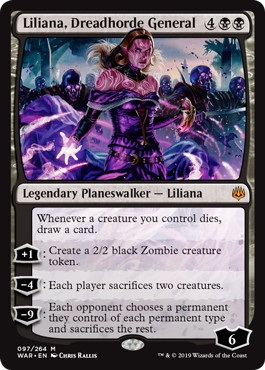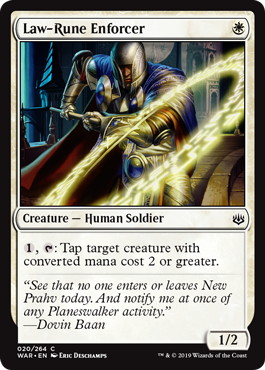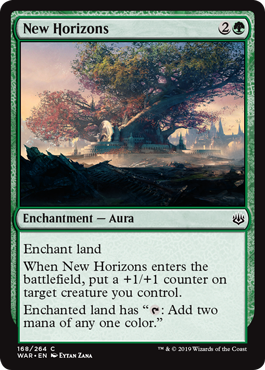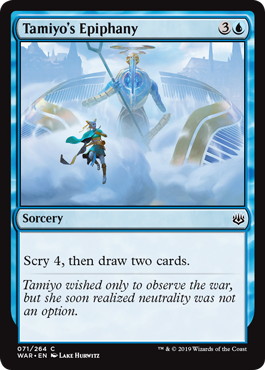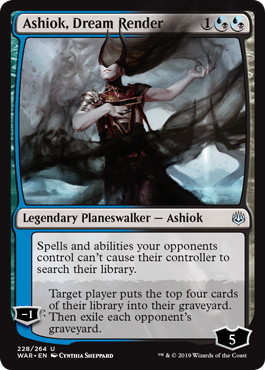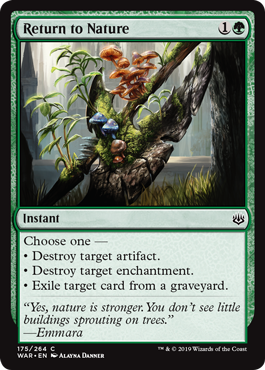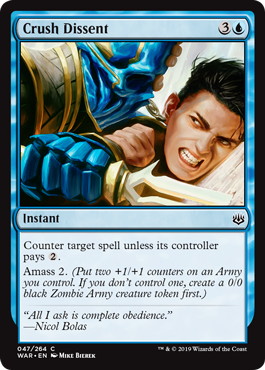Editor’s Note: fixed Creature Removal, Mana Sinks and Mana Fixers parts on 23rd April.
Introduction
Early March, I came up with the plan to write two pieces about Sealed. The first one would be a more theoretical approach. The second one would be applied to War of the Spark. Almost nothing was known about War of the Spark at that time. But it sounded like a good idea.
I found my first piece about Sealed more difficult to write than I anticipated. I was actually pretty stressed when it went. I put a lot of work into it and I wasn’t even sure it would be very useful or informative to anyone. But feedback on my article was overwhelmingly positive. It also reached quite a lot of people. I’m really happy and proud about this.
This article I’ll focus on War of the Spark. This set seems wild and unlike anything we’ve seen before. But I really want my follow-up article to help you, whether it’ll be at your Prerelease or at Magic Fest London. Time to delve into War of the Spark!
New Mechanics
Every new set brings us a couple of new mechanics. Often these mechanics give a good indication about how fast the Sealed format will be and what might be important. War of the Spark has two factors which I think will define the Sealed metagame: Amass and Planeswalkers.
Planeswalkers
Planeswalkers in Sealed were pretty easy in the past. Most of the time they were very strong and could be a gameplan on their own. Especially the more expensive Planeswalkers tend to be like this. The average 5 mana Planeswalker looked like this:
None of this holds true in War of the Spark. There is a Planeswalker in every booster pack. So each Sealed pool will have 6 or maybe 7 Planeswalkers. That’s a lot. All Planewalkers in War of the Spark have a static ability. The Uncommon ones only have a minus ability. The Rare ones have a plus ability and a minus or an ultimate. The Mythic ones seem to be the same as they’ve always been.
I don’t think all the Uncommon Planeswalkers are playable, but most seem to be. Exceptions seem to be cards like 《Teyo, the Shieldmage》 and 《Jiang Yanggu, Wildcrafter》. Between a decent static ability and a lot of abilities that create some advantage, most other range between decent and very strong. Next to that, 10 of the Uncommon Planeswalkers have a hybrid mana cost, which makes them easier to be played in Sealed. I would expect every Sealed deck to play at least 3 Planeswalkers, with some playing 5 or 6. I cannot stress enough how huge this impacts Sealed.
Planeswalkers generate incremental advantage. The longer a Planeswalker stays in play, the greater the advantage you’ll get. With a static ability and Proliferate in the set, this also holds true for the Uncommon Planeswalkers with only a minus ability. For Sealed deckbuilding you’ll want ways to pressure your opponent’s Planeswalkers or ways to protect yours. Having creature removal in hand, but no pressure, while your opponent is generating advantage through their Planeswalkers is a recipe for disaster. The same creature removal could be very good if you’re the one generating advantage through Planeswalkers, however.
Amass
Amass is a rather odd mechanic. At face value, a lot of the Amass cards seem well worth it. Take for example 《Bleeding Edge》 and 《Lazotep Reaver》. Both cards are pretty strong and provide good value on their own, if they’re creating a creature. If you’re putting one or two additional +1/+1 counters on your 6/6 Army, it’s a lot less enticing. Every additional Amass card effectively works as an Aura.
In a way, Amass works better for the player who is blocking. Cards like 《Lazotep Reaver》 or 《Dreadhorde Twins》 give you two blockers, if you don’t already have an army out. In most formats, chump blocking is pretty bad in Limited. This could be a different story in War of the Spark, because you’re protecting Planeswalkers.
As both Amass and a lot of Planeswalkers give you small tokens, I’d expect the board to clog up rather easily. Evasion seems very important to pressure Planeswalkers, while inevitability will be worth a lot.
Theoretical Analysis
War of the Spark is entirely known. After going through the spoiler a couple of times, I want to learn more about the commons and Uncommon in the set. After all, commons and Uncommons are what define the limited format. These are the first questions I want answers to:
Getting answers to these questions helps me get a better first impression of what the set is about. I want to have a first impression about the War of the Spark Sealed metagame.
Creature Removal
In this list, I’ll also include conditional removal. It is very important to be aware of all the pieces of removal in a limited format, how conditional they may be. How you play and sideboard should be guided by what cards you’ve seen, but also what cards you can expect.
- War of the Spark
- – Creature Removal
《Gideon’s Triumph》
《Law-Rune Enforcer》
《Prison Realm》
《The Wanderer》
《Wanderer’s Strike》
-White (6)- 《Callous Dismissal》
《Kasmina’s Transmutation》
《Totally Lost》
-Blue (3)-
《Liliana’s Triumph》
《Ob Nixilis’s Cruelty》
《Ob Nixilis, the Hate-Twisted》
《Price of Betrayal》
《Sorin’s Thirst》
《Spark Harvest》
-Black (7)- 《Blindblast》
《Bond of Passion》
《Chandra’s Pyrohelix》
《Chandra’s Triumph》
《Cyclops Electromancer》
《Heartfire》
《Jaya’s Greeting》
《Jaya, Venerated Firemage》
-Red (8)-
As I said earlier, there will be a lot of tokens in this format. This makes 《Callous Dismissal》 even better than it otherwise would be. I should also mention 《Law-Rune Enforcer》 and 《Kasmina’s Transmutation》 don’t work against the opposing Army.
《Price of Betrayal》 might seem like an odd card, but since it can kill an Army or Planeswalker, I think it’ll be a fine playable.
The removal in War of the Spark seems pretty strong. I believe this makes Planeswalkers even better in Limited gameplay than they would normally already be, as it will be easier to protect them if there’s decent removal.
Average Creature Size
The average size of a creature tells a whole lot about how aggressive a format will be. By combining it with mana cost, you’ll get an idea about which turn you can expect which size. Of course, you have to make some generalizations. In this case, I just added Amass creatures have to their power and toughness. I did the same thing for creatures entering the battlefield with modification to their power of toughness.

Even though this just averages the power and toughness for each creature, a lot of information can be drawn from this:
Mana Sinks
When I talk about mana sinks, I mean ways to keep using your mana as the game progresses. Mostly, these are activated abilities with a mana cost or ways to get access to additional cards to spend your mana on. Note that I won’t include every card with an activated ability that costs mana, but only those you would actively want to use in the later stages of the game.
- War of the Spark
- – Mana Sinks
-White (1)- 《Ashiok’s Skulker》
《Augur of Bolas》
《Bond of Insight》
《Erratic Visionary》
《Kasmina, Enigmatic Mentor》
《Narset, Parter of Veils》
《Spellgorger Weird》
《Tamiyo’s Epiphany》
-Blue (8)-
The list of mana sinks is very short outside of blue. I even included a lot of cards that really only work in a specific type of deck. This means that having too many lands will be punishing if you don’t have a way to spend the mana. It also means you should value the available mana sinks higher than you usually would when building your deck.
Mana Fixers
The availability of mana fixers tells you a lot about the number of colors you should expect people to play in Sealed. If splashing cards is almost free, as it was in both Ravnica Allegiance and Guilds of Ravnica, then you should almost surely do it. If you have to play a bad mana base or include bad cards to be able to splash, I would advise against it.
- War of the Spark
- – Mana Fixers
This is a pretty short list of fixers. In addition to that, I wouldn’t want to rely on 《Jiang Yanggu, Wildcrafter》, 《Leyline Prowler》 or 《Prismite》 to fix my mana. Without a lot of mana sinks, cards like 《Mana Geode》, 《Firemind Vessel》 and 《New Horizons》 lose value too. As we saw when looking at the creatures in this set, it doesn’t seem like the ramping will be valuable either.
Having answered each of these questions, we have a better idea of what to expect in an average Sealed pool. This in turn gives you knowledge about what decks your opponent will be presenting.
Deckbuilding
Features of Each Color
War of the Spark returns to a more classic interpretation of the color cycle.
White and red have almost no mana sinks, which indicates these colors aren’t interested in a longer game. Both have decent, but often conditional removal. Black both has a decent amount of removal and mana sinks. While the black creatures are somewhat lacking in size, they make up for it by having access to Amass. Blue has by far the most use for it’s mana, but lacks both quality removal and quality creatures. Green is also back to its usual role, having the beefiest creatures and mana fixing, but almost no mana sinks or removal.
From analyzing the spoiler, I would expect Black to be the most played color in Sealed deck. So you’ll want your deck to have answers to whatever Black is doing. Next to that, make sure you have ways to pressure Planeswalkers. Small creatures that can’t beat a 2/2 in combat seem pretty useless, however. This creates an interesting dilemma where you need early drops, but their usefulness drops off quickly.
Avoiding Aggressive Decks
I believe aggressive decks will be pretty badly positioned in War of the Spark Sealed for the following reasons:
Premium Uncommon Planeswalkers
As was the case with the most recent sets, multi-colored cards are stronger than their mono-colored counterparts. For Sealed, this means your gold cards will be an indication of what colors you’ll want to play.
Make sure you have separate pile for your hybrid Planeswalkers. The following Uncommon hybrid Planeswalkers seem very strong in Sealed and should steer players opening them into one of their colors.
All of them are White or Black. White and Black also have the most removal spells. Note that none of these are Blue. While the Blue hybrid Planeswalkers might be decent in the right deck, they aren’t automatic inclusions in any way.
There are two of the Uncommon Planeswalkers I want to talk about separately: 《Davriel, Rogue Shadowmage》 and 《Ashiok, Dream Render》. These two Planeswalkers can both be useless or game winning. Davriel has a lower ceiling and higher floor. At its best, it will make your opponent discard three cards and pressure their life total. At its worst, Davriel is a terrible top deck when you’re behind. Ashiok is more extreme. If you play Ashiok, it should be your plan to win by Ashiok. Build your deck in such a way if you do. If the format turns out as I expect it will, both will be respectable cards to put in your deck.
How Many Lands Should I Play?
I believe most War of the Spark Sealed decks will play the regular 17 lands without additional sources. If there’s no use for the additional mana, you shouldn’t play it. I expect decks will be straight two colors, with maybe a small splash.
Is 《Naturalize》 Effect Necessary in the Main Deck?
This set contains few useful artifacts or enchantments, so don’t put something like 《Return to Nature》 in your main deck.
War of the Spark Gameplay
I feel like I’m pretty much repeating myself in each part, but Planeswalkers will be what sets the gameplay apart. Not only will Planeswalkers play a huge part in strategic decisions, they also come with static abilities. Some Planeswalkers will be played because of the static abilities, others have static abilities which feel like flavor text. But all these effects have their uses. Don’t be the one who casts 《Band Together》 when your opponent controls 《The Wanderer》. 《Kaya, Bane of the Dead》‘s mere existence might make including 《Lazotep Plating》 a poor decision.
I believe 《Aid the Fallen》 is a card that very much influences how you play against or with black decks. If you don’t have anything with Hexproof, Kaya’s static ability is completely worthless. You would rather let your opponent have a useless Kaya in play than a Kaya that can be returned to their hand with 《Aid the Fallen》. If your opponent is playing a Blue-White deck however, your opponent might have plenty of ways to Proliferate onto Kaya. So killing it if you have a chance probably is your best course of action.
Playing against Planeswalkers isn’t the easiest thing. Knowing what to attack and how your opponent will choose to block won’t be easy. Especially early in the format, when players lack the experience of playing with and against a lot of Planeswalkers, I fully expect everyone to choose less than optimal lines. Carefully go through each combat. Consider how you expect your opponent to block when choosing a certain line. What will the result be? Especially with the new kind of Planeswalkers, always ask yourself if it’s worth the cost to kill it.
For War of the Spark Sealed, I recommend choosing to start the game. The easiest way to get an advantage in the battle of Planeswalkers is to cast the first one. Each additional turn a Planeswalkers sit in play, it will give you more advantage.
Sideboarding
If you’ve read my previous article, you’ll know I think sideboarding is a very important skill in Sealed deck.
Make sure you know what cards you have in your pool. Take these three commons: 《Blindblast》, 《Davriel’s Shadowfugue》 and 《Crush Dissent》. All three of these have the possibility of being a clean 2-for-1. Yet none of them should always be in your deck. Consider your options, think about when a certain card will be useful. How do you expect the match to go?
In most Sealed formats, I don’t really care about play or draw. Both play and draw have upsides. Even if I have a preference, it won’t be a strong one. In War of the Spark however, if your opponent plays a turn 3 and turn 4 Planeswalker and you have no way of pressuring them, don’t expect to win the game. Boarding in more early threats on the draw might be the right call, especially if your opponent showed a lot of Planeswalkers in the first game.
Wrapping Up
Don’t forget to watch your opponent play. Do they show a tendency of defending their Planeswalkers too much? Do they always just attack with all their creatures on your Planeswalker? New cards and mechanics always bring a learning curve. Exploit your opponent’s tendencies.I hope you found some things you hadn’t considered yet in my article. Use all the information you can find and hopefully it’ll help you grow as player. Have fun playing with War of the Spark!
Pascal Vieren @VierenPascal on Twitter





